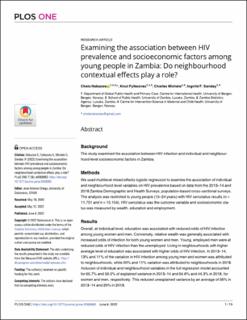| dc.contributor.author | Nakazwe, Chola | |
| dc.contributor.author | Fylkesnes, Knut | |
| dc.contributor.author | Michelo, Charles Cheembo | |
| dc.contributor.author | Sandøy, Ingvild Fossgard | |
| dc.date.accessioned | 2022-09-21T09:38:13Z | |
| dc.date.available | 2022-09-21T09:38:13Z | |
| dc.date.created | 2022-09-14T14:47:18Z | |
| dc.date.issued | 2022-06-08 | |
| dc.identifier.issn | 1932-6203 | |
| dc.identifier.uri | https://hdl.handle.net/11250/3020142 | |
| dc.description.abstract | Background: The study examined the association between HIV infection and individual and neighbourhood-level socioeconomic factors in Zambia.
Methods: We used multilevel mixed effects logistic regression to examine the association of individual and neighbourhood level variables on HIV prevalence based on data from the 2013–14 and 2018 Zambia Demographic and Health Surveys, population-based cross-sectional surveys. The analysis was restricted to young people (15–24 years) with HIV serostatus results (n = 11,751 and n = 10,154). HIV serostatus was the outcome variable and socioeconomic status was measured by wealth, education and employment.
Results: Overall, at individual level, education was associated with reduced odds of HIV infection among young women and men. Conversely, relative wealth was generally associated with increased odds of infection for both young women and men. Young, employed men were at reduced odds of HIV infection than the unemployed. Living in neighbourhoods with higher average level of education was associated with higher odds of HIV infection. In 2013–14, 13% and 11% of the variation in HIV infection among young men and women was attributed to neighbourhoods, while 20% and 11% variation was attributed to neighbourhoods in 2018. Inclusion of individual and neighbourhood variables in the full regression model accounted for 65.7% and 59.5% of explained variance in 2013–14 and 64.6% and 44.3% in 2018, for women and men, respectively. This reduced unexplained variance by an average of 56% in 2013–14 and 29% in 2018.
Conclusion: We found that HIV infection among young people in Zambia is more strongly associated with individual-level socioeconomic factors compared to neighbourhood factors. Individual-level education remains an important socioeconomic factor associated with reduced odds of HIV infection. This suggests that the HIV response in Zambia should still focus on individual level prevention strategies. | en_US |
| dc.language.iso | eng | en_US |
| dc.publisher | PLoS | en_US |
| dc.rights | Navngivelse 4.0 Internasjonal | * |
| dc.rights.uri | http://creativecommons.org/licenses/by/4.0/deed.no | * |
| dc.title | Examining the association between HIV prevalence and socioeconomic factors among young people in Zambia: Do neighbourhood contextual effects play a role? | en_US |
| dc.type | Journal article | en_US |
| dc.type | Peer reviewed | en_US |
| dc.description.version | publishedVersion | en_US |
| dc.rights.holder | Copyright 2022 the authors | en_US |
| dc.source.articlenumber | e0268983 | en_US |
| cristin.ispublished | true | |
| cristin.fulltext | original | |
| cristin.qualitycode | 1 | |
| dc.identifier.doi | 10.1371/journal.pone.0268983 | |
| dc.identifier.cristin | 2051690 | |
| dc.source.journal | PLOS ONE | en_US |
| dc.identifier.citation | PLOS ONE. 2022, 17 (6), e0268983. | en_US |
| dc.source.volume | 17 | en_US |
| dc.source.issue | 6 | en_US |

